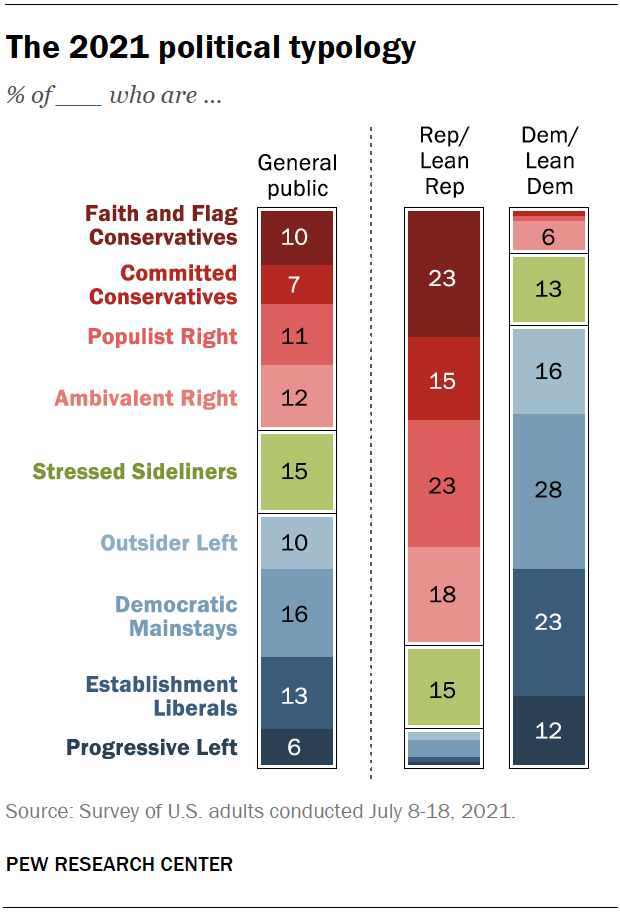Partisan polarization feels like a fact of life. Media outlets and social media algorithms alike gravitate toward the extremes, so much of what we hear and see confirm this perception. Our political leaders, on both sides of the aisle, appeal to the most radical parts of their base to avoid primary challengers. Common ground is hard to find and problems are harder to solve.
But polarization as a concept obscures a great deal of complexity. While our parties have moved apart over the past several decades, that movement has not created homogeneity. Parties, especially in our two-party system, are big, diverse coalitions that try to maximize votes in order to win elections. They must appeal to disparate groups who sometimes have different policy goals or prefer different approaches to the same set of problems.
The Pew Research Center uses survey data to discern who, exactly, stands beneath these partisan umbrellas. The organization updates these categories periodically and then invites anyone to take their “typology” quiz to see where they land in the current reality. Pew recently updated its categories and the results are intriguing, and, at least for me, descriptive of our present time and place.

Pew believes each party has four different groups of supporters, while a ninth group, the “Stressed Sideliners,” are somewhat disconnected from the political system. In the image above, you see the size of those groups in relation to the general public and the party itself. So, 10% of the population are “Faith and Flag Conservatives,” and they make up 23% of the Republican coalition. The “Democratic Mainstays” comprise almost 16% of the population and 23% of Democratic supporters.
While the entire report is worth investigating, a few things merit comment. First, the Populist Right appears to be driving the Republican agenda, at least rhetorically. They are mostly conservative, but have sharply different views from Committed Conservatives and the Ambivalent Right when it comes to immigration, and they are highly suspicious of elements of capitalism. They are the only Republican group where a majority claim that businesses make too much profit, taxes should be increased on the wealthy, and that the economic system favors the powerful. This group overlaps with elements of the Progressive Left, which supports at least the idea of “horseshoe theory,” where ideologies grow apart until the extremes, where they actually get closer.*
Second, Faith and Flag Conservatives and the Populist Right are the most supportive of Donald Trump within the Republican coalition. Faith and Flag Conservatives are not only religious, but want the government to uphold and promote traditional religious values. A majority of them believe Donald Trump won the 2020 presidential election and think too much attention has been paid to the events of January 6, 2021. These Republicans are most likely to label themselves “very conservative.”
Third, this breakdown of the two major parties gives a good indication of why neither party can effectively govern when in power. Within these groups, there are cross-pressures on key issues that prevent meaningful policies from advancing. For example, the Progressive Left and Establishment Liberals have similar views of America’s problems, but they support different remedies. Progressives are seeking systemic change, while Liberals don’t support radical solutions. Nearly two-thirds of progressives want a “greatly expanded” government, while only one-third of other Democrats agree.
The same is true within the GOP, but on different dimensions. The Ambivalent Right is conservative and traditional on matters of government size, the economy, race, and gender, but it supports drug legalization and is moderate on abortion. Most interestingly, Pew asked respondents if they thought same-sex marriage was “bad for society.” Of the four Republican groups, in only one, Faith and Flag Conservatives, did a majority (68%) say “yes.” In contrast, only 29% of the Ambivalent Right agreed.
Fourth, and finally, there is little hope of a third party emerging if Pew is correct and current conditions hold. The three groups that show the most dissatisfaction with the two major parties–Stressed Sideliners, Outsider Left, and Ambivalent Right–make up more than a third of the public (37%), which is roughly in line with recent history. However, Pew’s evidence suggests there is not enough policy overlap between them to build a meaningful platform. While partisan discontent may be high, there is not enough agreement on the nature of the discontent to do much about it.
*Anyone looking for a rough explanation for what is happening right now in Ohio’s Republican U.S. Senate primary could do much worse than assuming that the core, activist elements of the GOP fit into this category. That is the only way to explain the behavior of J.D. Vance, Josh Mandel, and the rest of the hopefuls.
 Bert Wheeler
Bert Wheeler
 Jeff Haymond
Jeff Haymond
 Marc Clauson
Marc Clauson
 Mark Caleb Smith
Mark Caleb Smith
 Tom Mach
Tom Mach